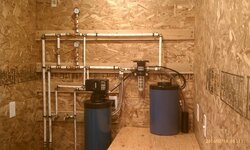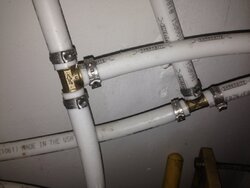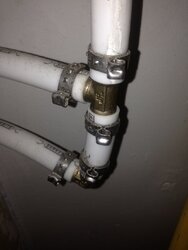What's preferred, copper or stainless? I'm looking at the HD web site, and apparently copper or stainless is available. The copper is a ring, the tool needs a gauge to calibrate it, and a special tool to remove the ring from a fitting. The stainless has a clip on it, is easily removed. The copper is cheaper than stainless. I can see insulation going over the copper easier. Is one better than the other?
PEX Crimp Rings: Copper or Stainless?
- Thread starter velvetfoot
- Start date
-
Active since 1995, Hearth.com is THE place on the internet for free information and advice about wood stoves, pellet stoves and other energy saving equipment.
We strive to provide opinions, articles, discussions and history related to Hearth Products and in a more general sense, energy issues.
We promote the EFFICIENT, RESPONSIBLE, CLEAN and SAFE use of all fuels, whether renewable or fossil.
You are using an out of date browser. It may not display this or other websites correctly.
You should upgrade or use an alternative browser.
You should upgrade or use an alternative browser.
- Status
- Not open for further replies.
Not particularly. Copper is cheaper. I've never heard of calibrating the crimper. You can get a crimper that is composed of two blocks where you tighten bolts to pull the blocks together. The nice hand operated crimpers are 60 to 80 bucks or something. No calibration.
Highbeam
Minister of Fire
What's preferred, copper or stainless? I'm looking at the HD web site, and apparently copper or stainless is available. The copper is a ring, the tool needs a gauge to calibrate it, and a special tool to remove the ring from a fitting. The stainless has a clip on it, is easily removed. The copper is cheaper than stainless. I can see insulation going over the copper easier. Is one better than the other?
Great question. I own the sharkbite brand copper crimper that does 1/2" and 3/4" bought for 60$ from home depot. It's freaking awesome. The calibration tool is a go-nogo gauge for the crimp to be sure that the proper crimp is set. I don't use this for all crimps, you get a feel for the crimp pressure needed. I have made about 100 connections and have never had a crimp be out of spec or leak.
The big copper crimper is a large tool and takes a lot of force to use. This means, to me, that the crimp is quite permanent.
The SS rings are okay but they seem hokey to me, more like a hose clamp. The tool is smaller, easier to use, but not cheaper. The big, and only, advantage to the SS system is that the same tool does all pipe sizes. But really, how many sizes do you need?
Both types are removable. I have removed plenty of copper rings without a special tool. You just cut off the ring, pull the pipe off the fitting, cut off the damaged 1/2"+ of pipe and it's like it never happened. You can reuse the fitting with a new ring.
I prefer copper. I do not regret going with the copper rings. If I was weak, the SS crimper is easier but looks amateur.
Here is my most recent iron filter project. Mostly 3/4". Oh and they don't tell you this but after you make the crimp, you can turn the fitting to line things up. It's not like solder.
Attachments
Highbeam
Minister of Fire
I understand having it all sharp angles and stuff looks nice, but isn't one of the major pros of pex that you can eliminate fittings? I ran all the way from source to fixture without any fittings if at all possible.
Couple reasons:
1) Maybe you've never worked with 3/4" pex from a roll. That stuff does not unroll, it is very very stiff and is a nightmare to work with.
2) In a lab setting, on a wall like this, I want neat and clean vs. a snake nest. Yes, it looks nice, but also it is well supported, lots of tees that are all straight with no stress.
3) Easier to assemble and crimp when everything is in a row.
Under a house, with half inch runs, yes it is great to use a big manifold and zero fittings. Fittings introduce restriction, cost a dollar or so, and create a slightly higher chance for a leak at the fitting.
Last edited:
Highbeam
Minister of Fire
Highbeam, how did you cut the ring? Dremel?
Yes. I buzz the soft copper rings off with a thin cutoff wheel. Only cut until you see the white pex underneath being careful not to cut into the brass. Of course, this is only to save the buck a new fitting costs. Even after you remove the crimp ring, the pex will often be held on pretty well so you need to tug it off.
I tried nipping the copper with a pair of dykes but the copper doesn't cut like that, it squirts out of the jaws.
I only had to remove the crimps around a temporary bypass. You should not have to remove a fitting very often.
I like the stainless fittings because one crimper does any size pipe. I think the copper probably is a little more secure though.
semipro
Minister of Fire
I can attest to that - very frustrating.1) Maybe you've never worked with 3/4" pex from a roll. That stuff does not unroll, it is very very stiff and is a nightmare to work with.
semipro
Minister of Fire
I like the stainless better because:
- Stainless steel is much stronger than copper and more corrosion resistant. (860 versus 210 MPa ultimate tensile strength) That said, copper doesn't corrode that fast either but still...
- The crimping tool fits better in tight spots which has been big plus many times
- One crimping tool fits most if not all.
- As an auto mechanic for 15 years I never once saw one of the SS clamps fail and was impressed by how hard they were to cut off. They are used on power steering hoses and other places.
Highbeam
Minister of Fire
Stainless steel is much stronger than copper and more corrosion resistant. (860 versus 210 MPa ultimate tensile strength) That said, copper doesn't corrode that fast either but still...
As I recall, the SS clamps are much smaller too. Aren't they skinny? Might make it easier to get them on the "sweet spot" of the fitting.
semipro
Minister of Fire
I went to the shop and grabbed one for 3/4" tubing and the width is 3/8". I"m not sure how that compares with copper ones.As I recall, the SS clamps are much smaller too. Aren't they skinny? Might make it easier to get them on the "sweet spot" of the fitting.
CaptSpiff
Minister of Fire
I like the SS cinch clamp rings over the copper crimp rings.
Mainly because the hand tool is the same for the 3 sizes of rings I use.
Also the cinch tool gets into tighter spaces as it doesn't need to be opened as wide.
It gets real tiring after a few dozen crimps to start a crimp tool with 2 hands. That's why the pros use the auto spreader tool.
There's no difference in leak rate between the cinch or crimp.
Make sure the Cinch Tool comes with a sacrificial calibration rod. I like to check it after 50-70 ops.
The SS cinch ring calibration will prevent over tightening as well as under.
Mainly because the hand tool is the same for the 3 sizes of rings I use.
Also the cinch tool gets into tighter spaces as it doesn't need to be opened as wide.
It gets real tiring after a few dozen crimps to start a crimp tool with 2 hands. That's why the pros use the auto spreader tool.
There's no difference in leak rate between the cinch or crimp.
Make sure the Cinch Tool comes with a sacrificial calibration rod. I like to check it after 50-70 ops.
The SS cinch ring calibration will prevent over tightening as well as under.
Hello
Looks like the SS cinch rings are very hard to remove and somtimes may be harder to put on without leaking.
See
https://www.heartlandowners.org/showthread.php/34079-PEX-connectors-stainless-crimp-OR-copper-rings
Here is someone who prefers the SS cinch ring because Stainless Steel because they are stronger and may last longer.
http://www.mobilehomerepair.com/phpbb/viewtopic.php?f=6&t=7225
"The cinch ring is a lot more engineered also. There is a stop built into it so you will know when you are fully seated. You can see the engineering in how the ring actually does "cinch" or tighten evenly around the fitting and you don't end up with the two bumps like on the copper ring."
Here is another reason for SS cinch, they will not leak if the line freezes like copper crimps!
http://diy.stackexchange.com/questions/1709/what-is-the-advantage-of-pex-pinch-clamp-vs-crimp-rings
"The stainless steel Cinch Clamps are stronger than the copper Crimp Rings. I know this from personal experience after working with frozen water lines. When the fitted connection freezes with water in the line it will cause the copper Crimp Ring to expand just enough to cause a leak when it thaws. The stronger stainless steel did not expand in a recent test. However, you cannot use the poly tees and elbows with Cinch Clamps."
I just had alot of work done by someone that only uses the SS Cinch fittings and no leaks.
Looks like the SS cinch rings are very hard to remove and somtimes may be harder to put on without leaking.
See
https://www.heartlandowners.org/showthread.php/34079-PEX-connectors-stainless-crimp-OR-copper-rings
Here is someone who prefers the SS cinch ring because Stainless Steel because they are stronger and may last longer.
http://www.mobilehomerepair.com/phpbb/viewtopic.php?f=6&t=7225
"The cinch ring is a lot more engineered also. There is a stop built into it so you will know when you are fully seated. You can see the engineering in how the ring actually does "cinch" or tighten evenly around the fitting and you don't end up with the two bumps like on the copper ring."
Here is another reason for SS cinch, they will not leak if the line freezes like copper crimps!
http://diy.stackexchange.com/questions/1709/what-is-the-advantage-of-pex-pinch-clamp-vs-crimp-rings
"The stainless steel Cinch Clamps are stronger than the copper Crimp Rings. I know this from personal experience after working with frozen water lines. When the fitted connection freezes with water in the line it will cause the copper Crimp Ring to expand just enough to cause a leak when it thaws. The stronger stainless steel did not expand in a recent test. However, you cannot use the poly tees and elbows with Cinch Clamps."
I just had alot of work done by someone that only uses the SS Cinch fittings and no leaks.
Attachments
Last edited:
bag of hammers
Minister of Fire
Everything Highbeam said. I have no experience with the SS crimps.
The copper stuff I did my camp / future house (1/2" and 3/4"). I did cut one crimp off of a manifold (had a do-over and didn't want to wreck that part) - I only had a small hack saw which did the trick in a couple minutes without damaging the barbed port on the manifold at all. A bit of a PITA, and if I had to cut more I'd probably be tempted to just cut the tubing and replace the fitting.
The copper stuff I did my camp / future house (1/2" and 3/4"). I did cut one crimp off of a manifold (had a do-over and didn't want to wreck that part) - I only had a small hack saw which did the trick in a couple minutes without damaging the barbed port on the manifold at all. A bit of a PITA, and if I had to cut more I'd probably be tempted to just cut the tubing and replace the fitting.
We have a tool that will remove the ring after clipping the hose. Basically you clip it as close to the fitting as you can get it then stick one half of the tool, almost like clippers but only one "sharpened" side, and it clips the ring without damaging the fitting. Just remove the ring and the small portion of pex still on there and it's good to go. We have also used a sawzall and hack saw.
Highbeam
Minister of Fire
I had to remove some 3/4" crimps this weekend and it was a total PITA. The copper rings come off easy. Getting the pex off of the fitting so that you can reuse the fitting is a huge PITA. These fittings had been crimped for a few months. The pex really grabs the ridges and wants to stay put.
I just used an air die grinder with a small 2-3" cut off wheel to zip off the crimps.
I just used an air die grinder with a small 2-3" cut off wheel to zip off the crimps.
semipro
Minister of Fire
I've found that I can remove the stainless clamps using side cutting pliers. You don't actually cut the clamp. The sidecutters are used to unhook the portion of the clamp ring that lies over barbs cut into the underlying part of the band.
Like Highbeam said getting the tubing off is much harder. I use a heat gun to warm the tubing and then it will come off. I then cut off the heat affected portion of tubing if I plan to reuse that section of PEX.
I haven't had a leak at a PEX connection yet.
Brass unions however, are another story.
Like Highbeam said getting the tubing off is much harder. I use a heat gun to warm the tubing and then it will come off. I then cut off the heat affected portion of tubing if I plan to reuse that section of PEX.
I haven't had a leak at a PEX connection yet.
Brass unions however, are another story.

Last edited:
bag of hammers
Minister of Fire
I picked up a pex "pocket" crimper on sale - does 1/2 and 3/4 using a set of vice grips to clamp - kinda klunky and slow to set up on the crimp, especially at first, but after I got into the swing of it I actually used this for the entire (small) project, instead of buying another tool that I would probably never need to use again. Not sure I would recommend this for a job of any size, but FWIW if you stumble across one for cheap, they do work fine if you really only have a handful of crimps to do as a DIY project.
Highbeam
Minister of Fire
I got the 57 dollar model at HD, and saw that they also had that pocket crimper.
Keep an eye on the set screw for the clamping force adjustment. I suddendly noticed that my crimping effort went way down and found that this screw had fallen out. I was lucky to find it and reset the adjustment per the instructions. Oh and the tool can get rusty so a little light oil before storage especially if you've been working in dirt.
My new, well a couple years old now, northwood RV uses pex and copper crimp rings for all of the plumbing. Same stuff.
Thanks for the tips. If pex hangs in there, it'd great. Then again, they're crucifying plastic beverage bottles now, aren't they?
Highbeam
Minister of Fire
Thanks for the tips. If pex hangs in there, it'd great. Then again, they're crucifying plastic beverage bottles now, aren't they?
The pex has been used for decades in Europe. I only really worry about rats chewing on it to get water. I have no rats but have seen pitcures of the damage.
- Status
- Not open for further replies.
Similar threads
- Replies
- 12
- Views
- 3K
- Replies
- 11
- Views
- 964
- Replies
- 8
- Views
- 3K
- Replies
- 16
- Views
- 4K




